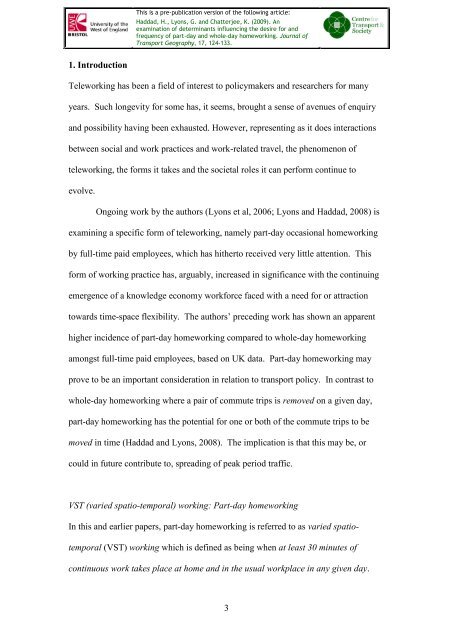Haddad, H. , Lyons, G. and Chatterjee, K. (2009) - UWE Research ...
Haddad, H. , Lyons, G. and Chatterjee, K. (2009) - UWE Research ...
Haddad, H. , Lyons, G. and Chatterjee, K. (2009) - UWE Research ...
Create successful ePaper yourself
Turn your PDF publications into a flip-book with our unique Google optimized e-Paper software.
1. Introduction<br />
This is a pre-publication version of the following article:<br />
<strong>Haddad</strong>, H., <strong>Lyons</strong>, G. <strong>and</strong> <strong>Chatterjee</strong>, K. (<strong>2009</strong>). An<br />
examination of determinants influencing the desire for <strong>and</strong><br />
frequency of part-day <strong>and</strong> whole-day homeworking. Journal of<br />
Transport Geography, 17, 124-133.<br />
Teleworking has been a field of interest to policymakers <strong>and</strong> researchers for many<br />
years. Such longevity for some has, it seems, brought a sense of avenues of enquiry<br />
<strong>and</strong> possibility having been exhausted. However, representing as it does interactions<br />
between social <strong>and</strong> work practices <strong>and</strong> work-related travel, the phenomenon of<br />
teleworking, the forms it takes <strong>and</strong> the societal roles it can perform continue to<br />
evolve.<br />
Ongoing work by the authors (<strong>Lyons</strong> et al, 2006; <strong>Lyons</strong> <strong>and</strong> <strong>Haddad</strong>, 2008) is<br />
examining a specific form of teleworking, namely part-day occasional homeworking<br />
by full-time paid employees, which has hitherto received very little attention. This<br />
form of working practice has, arguably, increased in significance with the continuing<br />
emergence of a knowledge economy workforce faced with a need for or attraction<br />
towards time-space flexibility. The authors‟ preceding work has shown an apparent<br />
higher incidence of part-day homeworking compared to whole-day homeworking<br />
amongst full-time paid employees, based on UK data. Part-day homeworking may<br />
prove to be an important consideration in relation to transport policy. In contrast to<br />
whole-day homeworking where a pair of commute trips is removed on a given day,<br />
part-day homeworking has the potential for one or both of the commute trips to be<br />
moved in time (<strong>Haddad</strong> <strong>and</strong> <strong>Lyons</strong>, 2008). The implication is that this may be, or<br />
could in future contribute to, spreading of peak period traffic.<br />
VST (varied spatio-temporal) working: Part-day homeworking<br />
In this <strong>and</strong> earlier papers, part-day homeworking is referred to as varied spatio-<br />
temporal (VST) working which is defined as being when at least 30 minutes of<br />
continuous work takes place at home <strong>and</strong> in the usual workplace in any given day.<br />
3

















